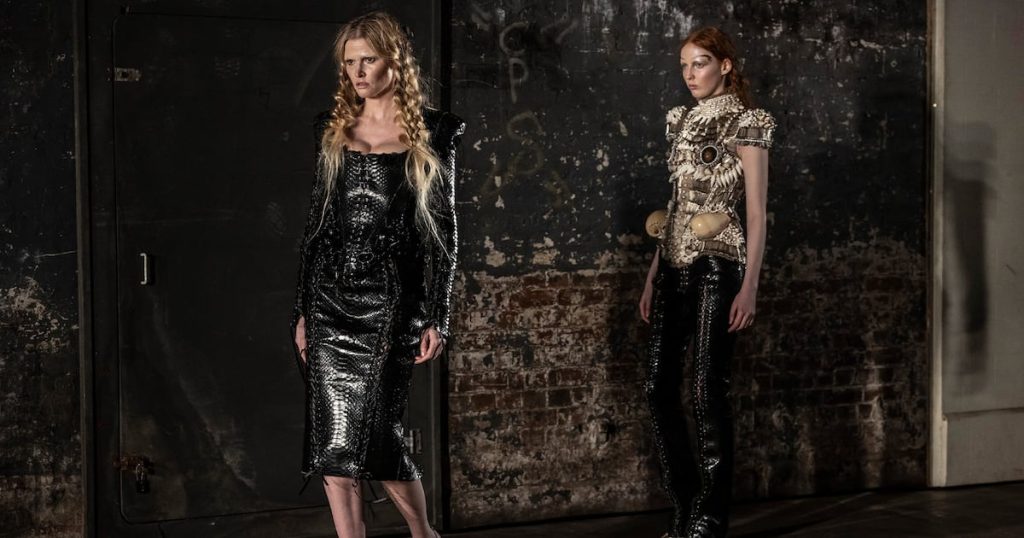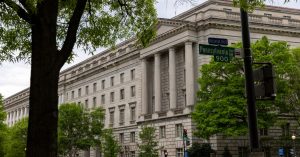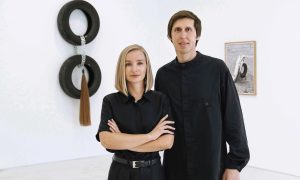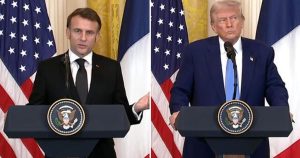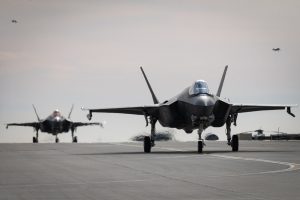
LONDON — Burberry closed what has been a lighter London Fashion Week schedule Monday night at a Tate Britain decked out in blue carpet and seating covered in Gainsborough-esque landscapes. Designer Daniel Lee staked Burberry’s claim to outfitting the British upper crust weekend in the country with a sumptuous array of autumnal hued outerwear fit for “Burberry weather” on an upstairs-downstairs cast that included Richard E. Grant, Lesley Manville and Elizabeth McGovern aka Lady Crawley of “Downton Abbey.” There was a focus to the collection that made for a more cohesive story than in previous seasons. “I’m in a good place right now,” said Lee when asked about his future at the company. And on the back of that show, you believed him.
While Burberry draws eyeballs to London, a chart that circulated last week comparing the earned media value generated by the main four fashion weeks put the British capital at the bottom of the pile by a large margin, spurring yet more hand wringing over the state of London Fashion Week. But it makes little sense to pit the might of the French luxury conglomerates that stage multi-million-dollar shows in Paris with the cottage industry of independent businesses in London while ignoring the value that the local fashion ecosystem creates in providing a fertile ground for gestating talent. EMV, schmee-M-V, I say. It’s an interesting metric, but by no means tells the full story.
The Central Saint Martins MA show, on the first night of London Fashion Week, had more than a few inspiring ideas that you could see taking hold on moodboards in Milan and Paris. See: Petra Fagerstrom utilising AI to produce mind bending lenticular textiles. You certainly can’t anticipate the effect talent like hers will have on fashion by measuring EMV.
London’s creative class has always thrived on being the naughty kid at the back of the bus. Take Simone Rocha, who took us back to school and her new imaginings of cliques, gangs and youthful rebellion. “I was always the emo kid,” said Rocha after a show that was deliberately more youthful than her usual ethereal oeuvre. Flailing pleats and ribbons were toughened up with denim and khaki, and adorned with chain belts that dangled with locks and clouds and giant faux fur hares, which cannily keyed into the rise of cute accessories. Rocha also relied on a cast of thespians such as Bel Powey, Minha Kim and Fiona Shaw to flesh out her vision of teenage kicks.
Harris Reed attempted to put two fingers up at the establishment with his punk themed collection. “Always be too fucking much!” declared Florence Pugh, who opened Reed’s show. That advice was taken quite literally with the horns and spikes thrusting out of gilded gowns for Reed’s coterie of celebrity fans.
Excess reigned at Dilara Findikoglu, who was back to cause welcome chaos after a season off. In a grimy night club, Findikoglu was on her own planet with rising Venuses in snakeskin leather and exquisite corsetry and second skin tailoring, earthed with battered Chucks. Shells and safety pins were pieced together into corsets and hair was shaved into layered jackets blending with the model’s own blonde tresses. “Millimetres matter,” said Findikoglu of the ultra-precise techniques that set her apart.
S.S. Daley designer Steven Stokey-Daley was unapologetic about his love letter to “old London style.” That meant ball gown skirts paired with country jackets and checked trench coats. Felted pieces mimicking the brushwork of the Scottish Colourists showed off Daley’s sense of craft. His grounded, product-focused collection was proof that London’s young designer class doesn’t need to rely on transgression for success.
The Dorchester provided the perfect backdrop to Huishan Zhang’s 1960s swans doing their couture turns down the sumptuous hall in bubble hemmed gowns and Swinging London clear plastic macs. Emilia Wickstead also turned to the 60s, mining the depths of Alfred Hitchcock’s female characters for a cinematic spin on high octane eveningwear, save for some draped knitwear and mock croc coats.
For Roksanda Ilinčić, artist inspiration is a natural fit, what with her art crowd clientele. The late Phyllida Barlow and her imposing installations were highly impactful on dresses made of curved found foam and highly textured fil coupé threads.
Erdem Moralıoğlu took it one step further by actively collaborating with a living artist: Kaye Donachie was commissioned to paint a portrait of Erdem’s mother a decade ago which then wound up on the opening look at his latest show. The Bloomsbury colour palette combined with naive flower embroidery haphazardly placed on gowns swelled to the sound of PJ Harvey’s cover of “Love Will Tear Us Apart.” The emotional rawness somehow didn’t tally up with the hemmed-in stiffness of the collection, however.
Paolo Carzana was on an emotional high after his rumpled and wrinkled ensembles wafted in and out of our vision at a show held in a small Georgian pub. You could almost smell the essential oils embedded into Carzana’s natural dyed twisted creations. If London was short on emotional moments this time round, this was an exception.
Some shows were literally threadbare — perhaps out of necessity. Jawara Alleyne said her cut-up deadstock checks were less about deconstruction and more about breaking down established national constructs, and his twisting of Britishness felt timely.
Conner Ives, meanwhile, raised a glass to American Tragedies with 1970s glamour walks coupled with Halston-cut scarf dresses and shag coats. The clothes perhaps didn’t quite match the evocative stride of Ives’ muses. The pressure to sell seemed to weigh heavily on what was a curiously commercial Fashion East show. Olly Shinder flew the coop by launching womenswear. Then, there was Nuba’s dystopian elegance and Louther’s grown-up tailoring fused with skate culture.” “Zero pounds” read a coin print Nuba top: a nod to the precarious finances of many of London’s designers.
In lean times, some designers opted not to stage a show at all. Marco Capaldo of 16 Arlington hosted a dinner at Almine Rech where Vogue cigarettes and a maraschino cherry dessert communicated the decadent mood of his Robert Palmer-inspired collection. Aaron Esh also hosted a dinner to showcase a capsule collection of eveningwear, followed by karaoke. Meanwhile, Stefan Cooke invited guests to place private orders over cake and beers, combining commerce with a preview of the season.
Doing a lot with a little has long been London’s MO. Kazna Asker created a vibrant culture trading souk market to showcase Yemeni-British fusionwear, exemplified by her signature tracksuit and hijab hybrids. Similarly Yaku Stapleton built an impressive immersive experience themed around an imaginary role-playing game, populated by characters dressed to gather and forage in a tropical biome. Both designers, and London’s wider wealth of fashion talent, deserve more eyeballs — or EMV, if you will.



